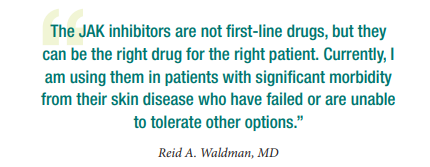Dermatologists weigh in on the benefits and potential drawbacks of prescribing JAK inhibitors.

With Ted Rosen, MD, FAAD

“A number of cytokine receptors signal via JAK1, 2, 3 and TYK2, collectively known as janus kinases (JAKs) and their associated signal transducer and activators of transcription (STATs). JAK inhibition can simultaneously block the function of multiple, presumably etiopathologic, cytokines. Therefore, JAK inhibitors are emerging as a new class of therapeutic drugs that might prove useful both topically and systemically in clinical dermatology,” said Ted Rosen, MD, FAAD, Professor of Dermatology at Baylor College of Medicine, Houston, Texas, and The Dermatology Digest Editor-in-Chief.
While new to the dermatology world, these drugs have been utilized in the rheumatology space since 2012, following the approval of tofacitinib (XELJANZ, Pfizer), a JAK1 and 3 inhibitor for the treatment of rheumatoid arthritis, according to Dr. Rosen.
“Indeed, a number of oral and topical JAK inhibitors have already been or will soon be approved for dermatologic indications. The indications clearly include psoriasis and psoriatic arthritis, atopic dermatitis, vitiligo, and alopecia areata. It is entirely probable that JAK inhibition will also prove invaluable for management of such diverse entities as lichen planus, sarcoidosis, lupus erythematosus, dermatomyositis, and hidradenitis suppurativa,” said Dr. Rosen.
However, dermatologists must be aware that these powerful agents may also carry significant risks, especially when administered systemically, he said.
“A special editorial in the January 2022 issue of the Journal of the American Academy of Dermatology calls out the fact that JAK inhibitors, to a large or small extent, may be associated with serious cardiovascular events, such as myocardial infarction and stroke; malignancy, in particular lymphoma and lung cancer; thrombotic events, such as deep venous thrombosis; and increased rates of all-cause mortality.1 It is, however, critical to note that much of the safety information is derived from post marketing surveillance data in rheumatoid arthritis (RA). The latter disorder is a multisystem inflammatory disease whose patients have an inherently increased risk of the potential adverse events enumerated above.”
“Thus, our enthusiasm for use of these potent novel agents must be tempered by the sobering realization that any time we utilize a JAK inhibitor, we are possibly placing the recipient in medical harms’ way,” he said.
As is true with all new and novel systemic agents, safety and efficacy must be balanced and continuously monitored, according to Dr. Rosen.
“We also know, in general terms, which individuals are at heightened risk. These include patients over age 50 or under 18; those with a personal or family history of malignancy; individuals whose lifestyle choices already are associated with an elevated cancer risk (e.g., smokers); and those with one or more risk factors for cardiovascular disease, including hypertension, hyperlipidemia, obesity, and diabetes.”
These potential problems were cited by the US Food and Drug Administration in a data safety communication issued based on a review of the findings in ORAL, a four-year post-marketing safety surveillance study exclusively involving tofacitinib administered for rheumatoid arthritis, according to Dr. Rosen.2,3
“Patients with active RA treated with tofacitinib had higher risks of major adverse cardiovascular events (MACE) and cancer compared with those treated with the TNF inhibitors. Due to the limited scope of the ORAL trial—a single drug given for a single indication—the enumerated concerns may or may not be generalizable to other JAK inhibitors. For example, the same adverse safety findings have not been observed in long-term clinical studies of upadacitinib (RINVOQ, Abbvie) in RA, psoriatic arthritis, and ankylosing spondylitis,” according to Dr. Rosen.
Authors of the JAAD special editorial called for dermatologists to be cognizant of the information in the FDA’s data safety communication so that they are prepared to answer questions from patients. The authors also encouraged their colleagues to consider the information about patient-specific risk factors for JAK inhibitor-associated adverse events in their prescribing decisions.
JAK Inhibitors in Dermatology
Jane M. Grant-Kels, MD, and Reid A. Waldman, MD, two of the authors of the special editorial, shared additional thoughts on the role and safety of JAK inhibitors with The Dermatology Digest.

Drs. Grant-Kels and Waldman concur that uptake of these drugs within dermatology will be tempered by fear over their safety harbored by patients and prescribers.
“Dermatologists need to warn patients about the potential side effects of JAK inhibitors to fulfill our obligation to patient informed consent and autonomy. Therefore, despite the effectiveness of these drugs, I fear that patient and prescriber concerns will relegate JAK inhibitors to second- and third-line therapeutics,” said Dr. Grant-Kels, Professor of Dermatology, Pathology, and Pediatrics, University of Connecticut Health Center, Farmington.
Dr. Waldman, Board-Certified Dermatologist, Dermatology Associates of Glastonbury, Glastonbury, Connecticut, said that safety concerns and warnings are constraining his personal use of JAK inhibitors.
“The JAK inhibitors are not first-line drugs, but they can be the right drug for the right patient. Currently, I am using them in patients with significant morbidity from their skin disease who have failed or are unable to tolerate other options,” he said.
In addition to safety concerns, the hindrances to adoption of JAK inhibitors include the burden of monitoring and counseling that accompanies their use.
“Between having to check labs, think about the potential for cytochrome P450-mediated drug-drug interactions and drug-comorbidity interactions, and counseling patients about the boxed warning, these drugs are much more cumbersome to prescribe than a biologic,” said Dr. Waldman.
“I believe that early adoption will be limited to practitioners who treat inflammatory skin diseases frequently and thereby have opportunity to become comfortable with using these drugs. In the long-term, however, increased adoption of JAK inhibitors may be limited by the emergence of potentially safer competitors, such as an OX40 antagonist.”
Dr. Grant-Kels noted that the potential for venous and arterial thromboembolic events with JAK inhibitor treatment raises an issue regarding their use in the sizeable group of women who are on a birth control pill.
She explained, “Should women with severe skin disease be excluded from treatment with a JAK inhibitor because of the already increased risk of thrombosis associated with some [birth control pills]?”
The approved dermatologic indication for JAK inhibitors represents another obstacle to their adoption because it affects manufacturer marketing. The prescribing information for upadacitinib and abrocitinib (CIBINQO, Pfizer) states that they are indicated for the treatment of adults and pediatric patients 12 years of age and older with refractory, moderate to severe atopic dermatitis whose disease is not adequately controlled with other systemic drug products, including biologics, or when use of those therapies are inadvisable.
“Although we often use drugs for off-label indications, manufacturers of the JAK inhibitors cannot legally advertise their drugs as an early line therapy, and that may affect the way dermatologists and patients perceive the role of the JAK inhibitors,” Dr. Waldman said.
Are all JAK inhibitors created equal? Based on differences in selectivity for binding to various members of the JAK family, it has been suggested that individual JAK inhibitors vary in their inherent safety profiles. This suggestion has at least some support based on the exceptional safety data from clinical trials involving an oral selective TYK2 inhibitor, deucravacitinib (Bristol Myers Squibb).
“The need for more data is especially highlighted by considering the updated Blackbox warning. There were no safety signals for clotting disorders in the phase 3 studies for abrocitinib and upadacitinib nor was there any concern in the phase 3 studies for tofacitinib. It was only during the long-term, 4-year ORAL study, which was conducted in a high-risk population, that risk of thromboembolic disorders with tofacitinib emerged,” said Dr. Waldman.
He continued, “From what we have seen in the phase 3 trials, upadacitinib appears to be more acnegenic than abrocitinib whereas abrocitinib causes more nausea. However, I think the key message is that it is important for dermatologists to recognize that the pharmacology of small molecule inhibitors like a JAK inhibitor is incredibly complex and cannot be reduced to ‘this one is more selective than that one’.”
Dr. Waldman and Dr. Grant-Kels observe that the only way to fully characterize the safety profile of individual JAK inhibitors and begin to understand potential safety differences would be to conduct long-term safety studies for each agent in the disease states for which they are ultimately approved. Again, it is important to remember that the immunologic state of an older male with RA is not the same as the baseline immunologic state in our dermatologic patients with psoriasis, vitiligo, alopecia areata, and atopic dermatitis.
“Dermatologists will never be truly free of concerns about using these medications long-term unless they are exonerated by findings from dedicated safety studies, and these studies will need to be done individually for each agent,” said Dr. Waldman.
References
- Murphrey M, Waldman RA, Durso T, Grant-Kels JM. Special editorial: When prescribing Janus kinase inhibitors for dermatologic conditions, be mindful of the Food and Drug Administration’s September 1, 2021, data safety communication. J Am Acad Dermatol. 2022;86(1):42-43.
- U.S. Food and Drug Administration. FDA requires warnings about increased risk of serious heart-related events, cancer, blood clots, and death for JAK inhibitors that treat certain chronic inflammatory conditions. December 2021 update. Accessed February 25, 2022. https://www.fda.gov/drugs/drug-safety-and-availability/fda-requires-warnings-about-increased-risk-serious-heart-related-events-cancer-blood-clots-and-death
- Thorley J. FDA expands JAK inhibitors warning: going beyond the data? The Lancet Rheumatol. October 11, 2021; 3(11): e757. https://doi.org/10.1016/S2665-9913(21)00323-4.
Dr. Waldman was an investigator for a dupilumab trial sponsored by Regeneron/Sanofi but received no direct compensation for his participation. He is on the board, holds a position, and has an equity stake in VeraDermics Inc, a dermatology-focused pre-clinical stage pharmaceutical company. Drs. Grant-Kels and Rosen have no conflicts of interest to declare.


